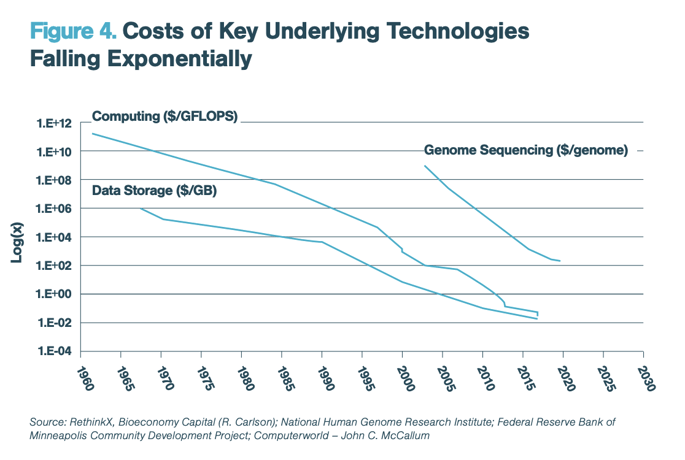By 2030, solar, wind and battery-based energy systems will have significantly lower overall costs than conventional energy systems in virtually all populated regions.
-
Based on available data, we estimate that energy currently represents approximately 30% of Precision Fermentation (PF) and Cellular Agriculture (CA) operating costs, +/- 20% depending on regional and operational factors.
-
Solar power, wind power and battery energy storage all produce electricity at near-zero marginal cost because they consume no fuels and have minimal operations and maintenance expenses.
-
RethinkX research has shown that the costs of SWB have fallen dramatically and predictably over the past 15 years, and are likely to continue to do so over the next decade.
-
By 2030, SWB-based energy systems will have significantly lower overall costs than conventional energy systems in virtually all populated regions.
-
PF and CA enterprises that are prepared to flexibly utilize seasonally available super power from SWB-based energy systems (whether grid scale or commercial scale) will be able to further reduce their energy costs, with the potential for the cost of electricity to approach zero under some circumstances.
Explore the evidence...
- There will be an increase in the amount of electricity used in the new food system as the production facilities that underpin it rely on electricity to operate. This will, however, be offset by reductions in energy use elsewhere along the value chain. Read more about the implications of the modern food disruption on p49 of our Rethinking Food & Agriculture report under 'Impact on Economic Sectors'.
- The disruption of food & agriculture will coincide with the proliferation of superabundant, clean energy caused by the disruptions of SWB within the energy sector. Learn more about Super Abundant Clean Energy on p52-53 of our Rethinking Energy report.
- Foods made using modern food production processes like PF are far more resource efficient than the industrial modes of production. For example, PF proteins are up to 100 times more energy efficient than the cow. Learn more about the precision fermentation process from RethinkX co-founder Tony Seba in this video.
- Modern foods will be about 10 times more efficient than a cow at converting feed into end products because a cow needs energy via feed to maintain and build its body over time. Less feed consumed means less land required to grow it, which means less water is used and less waste is produced. The savings are dramatic–up to 25 times less feedstock, 10 times less water, five times less energy and 100 times less land. Learn more about the fall in production and supply chain costs of the modern food disruption on p20 of our report.
- The cost of modern food products will be half that of animal products and they will be superior in every functional attribute–more nutritious, tastier and more convenient, with much greater variety. Wider economic benefits will accrue from the reduction in the cost of food, in the form of increased disposable incomes and from the wealth, jobs and taxes that come from leading the way in modern food technologies. Learn more about the implications of the modern food disruption on p7-8 of our report.
- We have now reached the point where scientists can design and synthesize almost any known or unknown molecule, while rapidly falling costs mean we can do so far more cheaply than ever before. Learn more about the technology convergences and cost curves driving disruption in the graph below, and on p17 of our report.

Witness the transformation
We are on the cusp of the deepest, fastest, most consequential disruption in food and agricultural production since the first domestication of plants and animals 10,000 years ago.
Modern alternatives to our industrial livestock model will be up to 100 times more land efficient, up to 25 times more feedstock efficient, 20 times more time efficient and 10 times more water efficient. They will also produce less waste.
Moreover, the disruption to the food & agriculture sector will coincide with the disruption of the energy sector by SWB. The disruption of SWB will create a superabundance of clean energy that will help to power the global modern food system.
Learn more about the disruption of food & agriculture.
Learn more about the disruption of the energy sector.
Published on: 12/07/23
